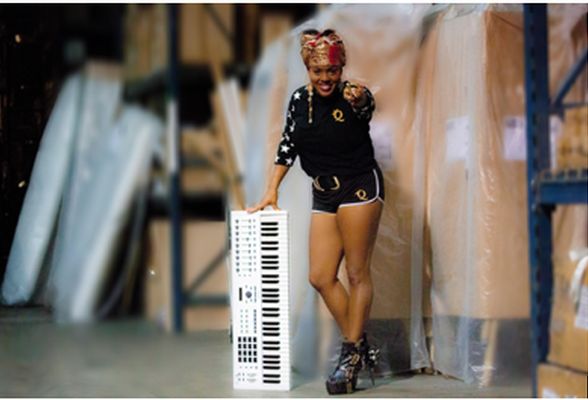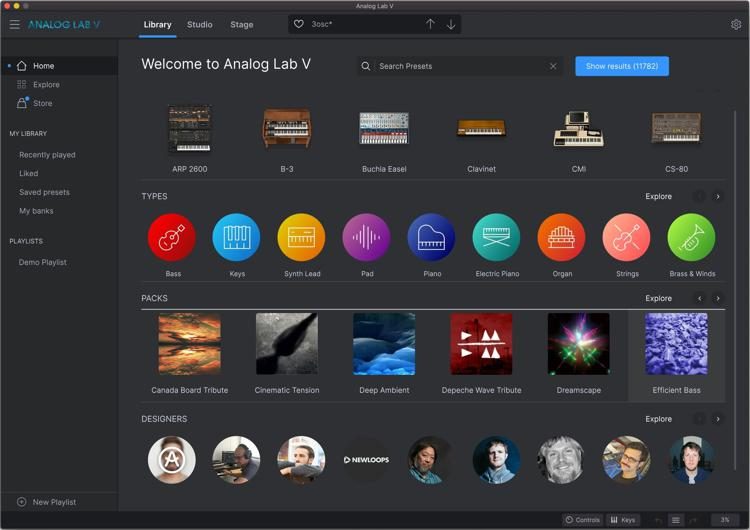
- #ARTURIA ANALOG LAB TURN OF OSCILLATING PAN MOD#
- #ARTURIA ANALOG LAB TURN OF OSCILLATING PAN UPDATE#
- #ARTURIA ANALOG LAB TURN OF OSCILLATING PAN MANUAL#
- #ARTURIA ANALOG LAB TURN OF OSCILLATING PAN SOFTWARE#
- #ARTURIA ANALOG LAB TURN OF OSCILLATING PAN WINDOWS 7#
You can also enable/disable each of them with a power button.įor each track you can have up to eight samples. On the left side is a slider that can make the same adjustments between the three samples like I mentioned earlier (A, B, C, or a blend between them).

Above that view are several settings to adjust different qualities of the sound itself: Flutter (random amount of tape speed fluctuation), Tape Saturation (adjusts the signal on the tape), Mechanics (imitates the various hardware noises), Noise Floor (adjust the audio noise level), Vel>Volume (keys played harder have more volume) and AT>Flutter (aftertouch will trigger the flutter effect).īelow the virtual keyboard there is a section for displaying the layout of the tracks in relation to the keys. Above the keyboard layout there is a view which shows the mechanics (or at least, a close resemblance) that would be found in the original hardware. On the left side there are controls to adjust the ADSR amplitude envelope. In the upper-right is a double-arrow icon which reveals the hidden settings of Mellotron V. By the way, those classic sounds can be switched out for several others that are included, but I will get to that later.

If you turn the control on the display fully to the left (9 o’clock position), then it will trigger all three sounds at once.
#ARTURIA ANALOG LAB TURN OF OSCILLATING PAN MOD#
You can also accomplish this using the mod wheel on your MIDI keyboard since it is pre-mapped that way. When you turn the control in-between A, B and C it will blend between the sounds as you’re playing.
#ARTURIA ANALOG LAB TURN OF OSCILLATING PAN MANUAL#
The manual goes into more depth on the history of the Mellotron if you’d like to peruse that topic. The first part of the sound titles I mentioned designate the model of the Mellotron that they came from: M400, Mark 2, etc. By default, those three sounds are A – Mk2 Flute, B – Mk2 3Violins, and C – M400 Cello. However, Volume, Tone (low pass filter) and Pitch (+/-2 semitones) are here, and a control to switch between the three available sounds labeled A, B and C. The On/Off button is just cosmetic, so it has no effect at all. In the lower-left are the only visible controls to make changes to the sound. Presets and banks can be loaded or saved from here and playlists of presets (first set, second set, encore, etc.) can also be created. In the upper-left is a search field to find a preset by its name, and they can be saved as favorites as well. There are also several style selections to choose from such as Ambient, Bizarre, Digital, Ensemble, etc. Once you’ve opened the browser screen there are several preset types you can choose from using the menu at the top, or by selecting buttons to filter the choices: Brass, Lead, Keys, Organ, etc. In the upper-left of the display is the browsing section, just like in most of the other Arturia plugins. It is a simple design, but there are some surprises tucked away which I will get to shortly. Upon loading it in your host of choice (or starting the standalone version), you will see the main display. It is 64-bit only and is available in AAX, AU, VST2, VST3 and standalone formats.
#ARTURIA ANALOG LAB TURN OF OSCILLATING PAN WINDOWS 7#
It will work with Windows 7 (or later) and on Macs with OS X 10.10 (or later).
#ARTURIA ANALOG LAB TURN OF OSCILLATING PAN SOFTWARE#
Mellotron V uses the Arturia Software Center for license activation. The Mellotron was very popular during the 1960s and 1970s and was used by notable artists at that time including The Beatles, The Rolling Stones, Led Zeppelin, Genesis and Yes. It was similar to how basic samplers work these days – minus the tape of course. Each tape had about eight seconds of playing time, and whenever you released the key, it would automatically rewind the tape to its original starting point. It had a separate tape for each note recorded at a certain pitch to match up with the key that you’d play. The original Mellotron was a polyphonic instrument which used recorded tapes of various instruments that would be played back when a key was pressed. The subject at hand here is the Mellotron V, which has 65 original tape racks from MKI, MKII, M300 and M400 Mellotrons. Also in this collection is the newly updated Analog Lab 4.

#ARTURIA ANALOG LAB TURN OF OSCILLATING PAN UPDATE#
The new plugins Arturia has added are CZ V, Synthi V, Mellotron V, and there is big update to B-3 V. Here we take a look at one of the new additions from the collection for this issue of SoundBytes Magazine. Arturia recently released the V Collection 7 which now includes a total of 24 instruments. Some of the plugins from the collection that we’ve covered are SEM V, Pigments, Jup-8 V, B-3 V, CMI V, and DX7 V. Many of these have been reviewed in past issues of SoundBytes Magazine. The V Collection series of music software plugins from Arturia includes a substantial list of instruments. Those classic sounds from the past have returned in an instrument with new functions including the ability to load samples.


 0 kommentar(er)
0 kommentar(er)
